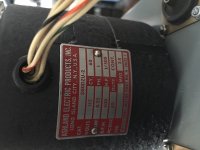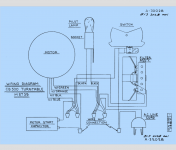Hello DIYAudio friends. I am seeking someone to build an AC synchronous hysteresis motor drive for my Gates CB 500 turntable that uses an Ashland motor (motor plate and wiring diagram attached). Time and lack of motor knowledge are preventing me from doing this myself. I like Pyramid's ideas and so, I asked him but he declined.
So, wondering if anyone would like to earn some $s and build a motor drive. Happy to pay for your time and expertise.
Thanks,
Pat
banpuku@mac.com
So, wondering if anyone would like to earn some $s and build a motor drive. Happy to pay for your time and expertise.
Thanks,
Pat
banpuku@mac.com
Attachments
Last edited by a moderator:
I suppose you want just *one*wondering if anyone would like to earn some $s and build a motor drive. Happy to pay for your time and expertise.
Setup fees would easily run U$10k or 20k ... if not more.
Are your pockets that deep?
Or to see it from anotherpoint of view: not sure you have any clue at all about what it takes to manufacture any Industrial product.
Anything which can be turned in a lathe and/or milled can reasonably made in "one" or "less than a dozen" quantities.
Your electric motor seems to have a cast body (takes a custom made injection die which then must produce some 5000 units to spread cost), punched rotor and armature laminations, same thing, and so on.
You *may* turn just one spindle, wind just one rotor/stator or make one squirrel cage, whatever´s needed.
The point being that to make a custom electric motor, from the ground up, is a big investment.
I suggest you search for a ready made electric motor which meets specs instead.
Forget about having "one" made.
Hi Guys, thanks for the responses. Just to underscore, I am seeking an AC motor DRIVE, not a motor. Hope this helps. Pat
Do you mean a sine generator with variable frequency for speed adjust(VFD)?
Delta 100W VFD Inverter VFD001L21A Variable Frequency Driver 220V 1phase for CNC 191673110674 | eBay
Delta 100W VFD Inverter VFD001L21A Variable Frequency Driver 220V 1phase for CNC 191673110674 | eBay
Do you mean a sine generator with variable frequency for speed adjust(VFD)?
Delta 100W VFD Inverter VFD001L21A Variable Frequency Driver 220V 1phase for CNC 191673110674 | eBay
The link is to a 200V-240V in, 3 phase output box.
banpuku probably has 120V. His motor is set up for 1-phase. It maybe could work as 2-phase. I don't know how well a 2-phase motor would run on 2/3 of 3-phase. Probably as lumpy as it does now.
I just wanted to know if this is what he wants...I made myself a sine generator, an amp(lm3886) and a step-up transformer wasting 40w on a heatsink to drive a 10w motor then i found better ways:
Pure Sine Wave Inverter Driver board EGS002 EG8010 + IR2110 Driver Module free shipping-in Inverters & Converters from Home Improvement on Aliexpress.com | Alibaba Group
Pure Sine Wave Inverter Driver board EGS002 EG8010 + IR2110 Driver Module free shipping-in Inverters & Converters from Home Improvement on Aliexpress.com | Alibaba Group
Last edited:
To avoid confusion Pat, perhaps you could explain precisely what you mean by a 'DRIVE'.I am seeking an AC motor DRIVE, not a motor. Hope this helps. Pat
Sorry for the confusion. When I say "drive" I mean a motor speed regulator / controller that will provide the following:
1. Stable & clean AC voltage source
2. Adjustable, precise, stable AC frequency
As an added bonus, but not required, adjustable phase angle to help minimize motor vibration due to cogging.
FWIW: I recall reading on this forum or audioasylum that industrial, off-the-shelf Variable Frequency Drives are not good for audio turntable use. That is why I have not pursued something like Delta VFD inverter.
Thanks, Pat
1. Stable & clean AC voltage source
2. Adjustable, precise, stable AC frequency
As an added bonus, but not required, adjustable phase angle to help minimize motor vibration due to cogging.
FWIW: I recall reading on this forum or audioasylum that industrial, off-the-shelf Variable Frequency Drives are not good for audio turntable use. That is why I have not pursued something like Delta VFD inverter.
Thanks, Pat
Last edited by a moderator:
According to ralphcooke (post #71 in your companion thread):As an added bonus, but not required, adjustable phase angle to help minimize motor vibration due to cogging.
"Hysteresis motors, at least the Papst ones I'm familiar with, and I believe also the Ashland, Bodine, and others of that type, are less efficient, but do not suffer from cogging."
they are very good actually, but you need steel shielded wires to the motor....as in the industrial environment.Most of the 100kva motors and invertors are attached to very sensitive Simatic automation and their signals can be disturbed easily by the motor and inverter noiseSorry for the confusion. When I say "drive" I mean a motor speed regulator / controller that will provide the following:
1. Stable & clean AC voltage source
2. Adjustable, precise, stable AC frequency
As an added bonus, but not required, adjustable phase angle to help minimize motor vibration due to cogging.
FWIW: I recall reading on this forum or audioasylum that industrial, off-the-shelf Variable Frequency Drives are not good for audio turntable use. That is why I have not pursued something like Delta VFD inverter.
Thanks, Pat
You don't need to build it.Buy Dual CS1219 or 1229.It already has built in the best hysteresis synchronous motor you'll ever be able to buy .
YouTube
I concur with almost any points. These motors offer a large torque and were running smoothly when new. BUT: Remember that they are 45 to 50 years old now. Usually the rubber supports have hardened, hence injecting mechanical hum into the chassis, the needle etc. And they're hard (but not impossible) to service. I've even managed to crack a rotor axis when disassembling the bearing bells from the stator. Others have irreparably destroyed the winding under this procedure. And you need to disassemble the motor completely if you just want to clean and lubricate the sleeve bearings and/or swap or replace the thrust bearing. On top of that the upper bearing often can be worn out due to the lateral force from the idler wheel. Bronze sleeve bearings of this size (4 mm bore, ½" outer dia) and type aren't available any more from stock. Swapping the upper and the lower bearings and applying oil of higher viscosity may cure the symptom for some years, though.
Besides of this I never wouldn't part out one of these fantastic Dual 1219 or 1229 fully automatic record changers just for the motor. It's a sacrilege!
Best regards!
The guy who tuned my turntable and made the measurements I posted before has already designed a drive unit. See:
Puresound: Motorsturing voor draaitafels: HAT Clean Power Supply (CPS-2)
See thge graphs at the end of the article. What you want is a 2-phase unit that provides very precise 90deg phase shift between phases, which is normally what the cap would (imprecisely) do.
The site is in Dutch but he caters to international customers and speaks good English. Mail him. His name is Jaap Pees, email jaap@hanzehifi.nl . Tell him I send you ;-)
Jan
Puresound: Motorsturing voor draaitafels: HAT Clean Power Supply (CPS-2)
See thge graphs at the end of the article. What you want is a 2-phase unit that provides very precise 90deg phase shift between phases, which is normally what the cap would (imprecisely) do.
The site is in Dutch but he caters to international customers and speaks good English. Mail him. His name is Jaap Pees, email jaap@hanzehifi.nl . Tell him I send you ;-)
Jan
Last edited:
I managed to open , clean, lube and put back the motor twice on dual 1219 as i have one.It is indeed a difficult task, but not impossible.Besides of this I never wouldn't part out one of these fantastic Dual 1219 or 1229 fully automatic record changers just for the motor. It's a sacrilege!
Best regards!
Dual made another very good motor which i happen to have , i actually have 3 identical and never used sm860-5.Their rubber washers are very good .When i said that an industrial VFD can do the job i said that because the 1219 has fully enclosed , thus shielded motor .You only need to use industrial steel shielded wires made specifically for this task and you won't have any induced noise into the turntable chassis.
I built a huge VFD version once , the performance was good, but i'd go class d at least for the motor!
The cheapest suggestion:
20v dell/lenovo laptop charger
tpa3116d2 2x 50w/1x100w class d amplifier
sine generator(xr2206, icl8038)
step up transformer from UPS 9v to 110/230v
For motors like Dual1219 you need to take care of only one thing, the frequency needs to be rock stable as the motor respond instantly to any freq variation.
Last edited:
Now there's even a cheaper approach that anybody can do :
Buy:
1.cheap old cd player.
2. cheapest 100w/4ohms amp (just one channel).The higher the power, the better.I used lm3886 kits...40w heat dissipation!!!
3.100...500w ups step-up transformer(9v...110/230v)
Burn a CD with 40 tracks in each of two ranges of frequencies:
48hz, 48.1, 48.2....52hz for 33RPM
70...84hz i don't remember exactly the frequency for 45RPM, i think it was 81hz
You need to adjust the volume on each track to have the Voltage/frequency ratio equal all the time.You have twice the frequency, you need twice the volume too.Now for small variations like 48...52hz there's no need for volume or voltage variation depending on the motor .Most motors will become more silent if the VF ratio is perfect all the time.
Interconnect the motor to step up transformer-amp-cd player and play the tracks untill you find the perfect frequency for your turntable speed.
When you find those two frequencies you just burn two cd's with each frequency.
You just play the cd and the turntatable will be singing 🙂
Buy:
1.cheap old cd player.
2. cheapest 100w/4ohms amp (just one channel).The higher the power, the better.I used lm3886 kits...40w heat dissipation!!!
3.100...500w ups step-up transformer(9v...110/230v)
Burn a CD with 40 tracks in each of two ranges of frequencies:
48hz, 48.1, 48.2....52hz for 33RPM
70...84hz i don't remember exactly the frequency for 45RPM, i think it was 81hz
You need to adjust the volume on each track to have the Voltage/frequency ratio equal all the time.You have twice the frequency, you need twice the volume too.Now for small variations like 48...52hz there's no need for volume or voltage variation depending on the motor .Most motors will become more silent if the VF ratio is perfect all the time.
Interconnect the motor to step up transformer-amp-cd player and play the tracks untill you find the perfect frequency for your turntable speed.
When you find those two frequencies you just burn two cd's with each frequency.
You just play the cd and the turntatable will be singing 🙂
Last edited:
Jan - I have been in contact with Jaap. Very accommodating. Just waiting learn his timeline for availability. What are your thoughts on his product quality? Thanks for the insight.
- Status
- Not open for further replies.
- Home
- Source & Line
- Analogue Source
- I want to hire someone to build an AC synchronous motor drive


